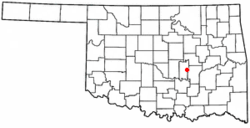Wewoka, Oklahoma
| Wewoka, Oklahoma | |
|---|---|
| City | |

|
|
 Location of Wewoka, Oklahoma |
|
| Coordinates: 35°8′58″N 96°29′40″W / 35.14944°N 96.49444°WCoordinates: 35°8′58″N 96°29′40″W / 35.14944°N 96.49444°W | |
| Country | United States |
| State | Oklahoma |
| County | Seminole |
| Government | |
| • Type | Council-manager |
| Area | |
| • Total | 4.8 sq mi (12.5 km2) |
| • Land | 4.8 sq mi (12.5 km2) |
| • Water | 0.0 sq mi (0.0 km2) |
| Elevation | 804 ft (245 m) |
| Population (2010) | |
| • Total | 3,430 |
| • Density | 714.6/sq mi (274.4/km2) |
| Time zone | Central (CST) (UTC-6) |
| • Summer (DST) | CDT (UTC-5) |
| ZIP code | 74884 |
| Area code(s) | 405 |
| FIPS code | 40-80550 |
| GNIS feature ID | 1099657 |
| Website | http://www.cityofwewoka.com/index.html |
Wewoka is a city in Seminole County, Oklahoma, United States. The population was 3,430 at the 2010 census. It is the county seat of Seminole County.
Founded by a Freedman, John Horse, and Black Seminoles in January, 1849, Wewoka is the current capital of the Seminole Nation of Oklahoma.
Wewoka's history begins with Freedman John Horse, who was also known as Gopher John. In the spring of 1849, Horse and a group of Black Seminoles founded a settlement near modern-day Wewoka. Seeking safety and autonomy from the Creek Nation, they established a community located at the falls of a small stream, lying in the fertile lands between the North and South Canadian Rivers. The steady rush of water over the falls gave rise to the name We-Wo-Ka – meaning "Barking Water" in the Mvskoke (Seminole) language. Other historians claim he named the settlement Wewokea after Osceola's second wife who was of both Seminole and African ancestry.
In autumn of 1849, Horse and Seminole chief Wild Cat led Seminole families into Mexico to avoid the attempts of slavers to raid families and capture people of African descent. The Mexican government offered Wild Cat, Horse and other Seminoles land in Mexico if they could rid the land of renegades who were terrorizing Mexican citizens. Wild Cat was the next hereditary chief of the Seminole Nation but the government appointed its first chief John Jumper instead. The descendants of Wildcat and his band were split for a time between Wewoka, Texas, and Mexico until 1918.
The city was founded in 1866 when Elijah J. Brown, an employee of the federal government led Seminole refugees from Leroy, Kansas to Indian Territory. During the American Civil War, the Seminole Nation had sided with the Confederacy, although many tribe members fled to the relative safety of Kansas, where they remained for the duration of the war. In 1866, after the Confederacy surrendered, the United States government required the Seminole Nation to sign a new treaty, which required them to emancipate their slaves, give freedmen who wanted to stay in the territory full rights as citizens, including voting in the tribe. Brown led the refugees back to Wewoka, here he built himself a house and established a trading post. Freedmen settled in Wewoka along with the Seminole and Elijah Brown was the only legal white settler in the town. The trading post had several subsequent proprietors before it was bought by two Seminole brothers, John Frippo Brown and A. J. Brown, and became the Wewoka Trading Company in 1891. Rev. James Ross Ramsey, a Presbyterian missionary, founded the Ramsey Mission (considered the first school in present Seminole County) in 1866. A post office was established on May 13, 1867 with E. J. Brown as first postmaster. The Seminole Nation made Wewoka their capital city and Seminole Governor John Brown had a log house erected at Wewoka as the Seminole capitol in 1877.
...
Wikipedia
